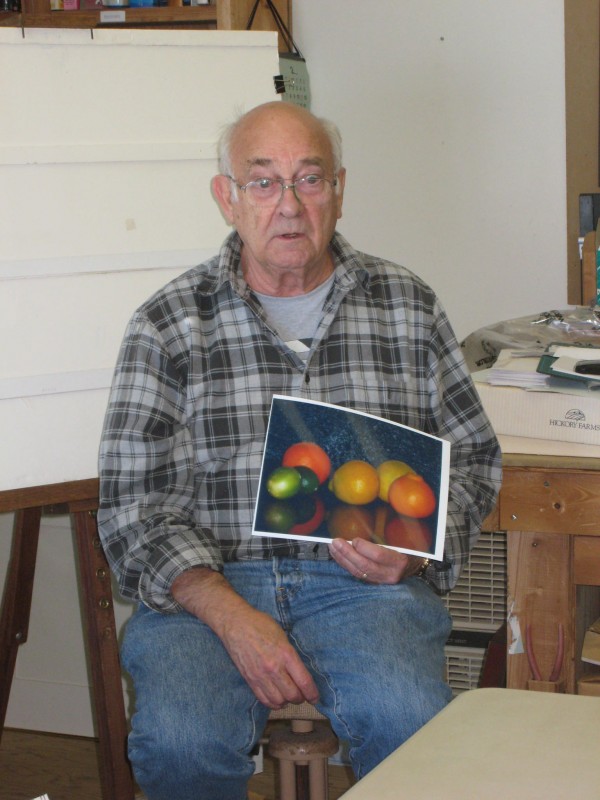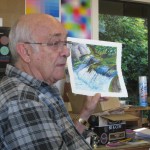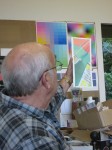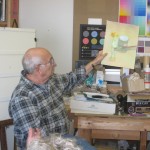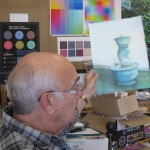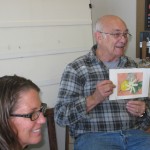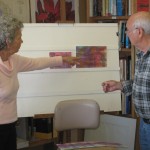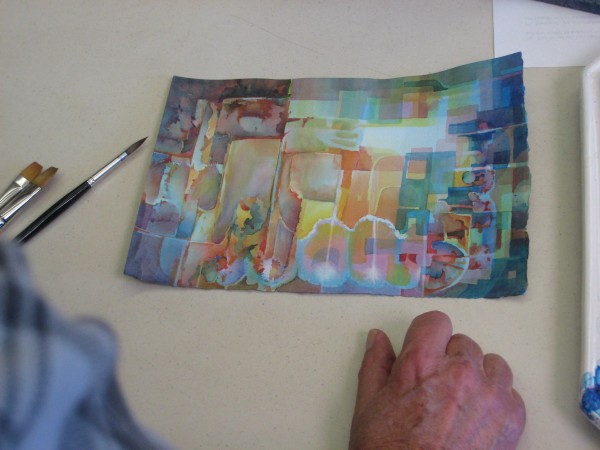Chris brought in a photo of fruit on a reflective surface, which Dick used to point out visual cues of surface qualities.
Critique: simple watercolor compositions focusing on surface
Tips for painting surfaces
A number of tips came out during the critique:
- Water and glass have two qualities in common, transparency and reflection. Use them to create more convincing and interesting results. Use principles of veils to explore the mist quality of water.
- Reflective surface will reflect anything in the environment – use your eyes and your mind to recognize that a surface will be influenced by the things around it. That’s how nature works, and it ties things together. It’s all relationship.
- If there’s a highlight, take care to leave it (for instance, in an eye or a reflection). It provides an important visual cue.
- If it’s worth doing, do it again and again. Each time will bring more sureness. Dick would do as many as five or six paintings for a major commission, working through different problems each time. Working in watercolor, he could do a complete painting in a day.
- Reserve white for a small accent (see above), rather than keeping it as the majority of the space, because it takes the scene out of context.
- Try to create exciting colors. You’re working with shape, and color – the problem comes when you say, “Grass!” Most of your viewers will look for subject matter, but the artists in the audience will look for visual excitement in your shapes and colors.
- To make grass more interesting and less flat, start with some yellow interspersed with white. This will promote vanishing boundaries when you add other colors over it.
- “I’m trying to get you to see what you paint – to recognize – to RE-COG-NIZE.”
How to plot reflections
Reflections behave differently than shadows. A shadow’s position depends on where the light source is, relative to the object. Reflections always point straight toward the viewer.
Why go to the trouble of using surfaces in a painting?
Great composing, whether in music or art, requires a heart, and a mind, that wants to share. These are tools under your command for conveying emotion as well as subject matter. To Dick, it is important to show each of us what can be achieved. You don’t have to use the tools, but be conscious of the choice. You have to work hard to be great, as a musician practices. Dick shared that this was the one year anniversary of his wife, Elly’s, death, and said, “You only get one life. Live every single moment. Don’t put it off. Enjoy the process.”
Seeing neighborhoods and painting demo
We used mat board Ls to frame “neighborhoods” in the demo piece. A neighborhood has a common language and culture. Look for a focal point, like a special park or restaurant.
Dick gave another painting demo, going into the ongoing piece and finding unresolved areas, joining some, highlighting places. Use gradations between light and dark, and warm and cool. Create areas of darker-than, lighter-than, where a shape transitions.

